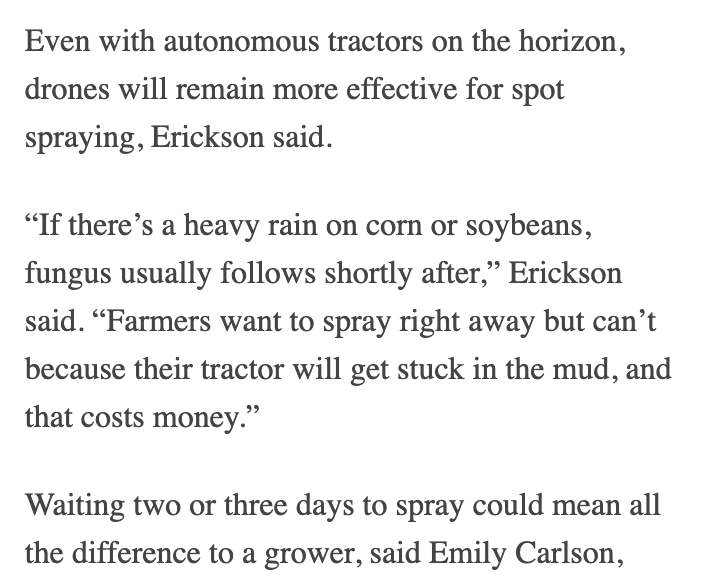Application of DJI agricultural drones in Canada
This year we received more calls and emails than ever before.
Actually, many countries tested drones on pesticides for already many years and actively to utilize the precise drone tech with our current tools, we can tell that everybody was excited about the results. Regarding the case of drones spraying pesticides on different crops, you are welcome to search the Internet for information. We have also compiled some cases of drone spraying pesticides for your reference. The link is at the end of the article.
Indeed, it can be used for vicious poisonous weeds before arable land no longer requires whole-field spraying, and drones can achieve spot spray. It also helps to work on the edge of the plot to reduce the spread of pests and diseases to the interior. However, the label isn’t coming out yet… Is drone an option for our Canadian growers?
What we have learned, an application for a label requires a lot of testing and research work, not something that can be done in a few years. Other countries, their local growers actively work with agronomists, ag experts, professors, and chemical companies, dedicated to testing and trying things out. After all, as clean and sustainable tech, this method can save 30-50% of pesticides and 80-90% of water.
I remember once a grower said:
The central part of the United States has begun to apply it on a large scale. The EU Plans To Reduce Pesticides By 50%. It wouldn’t be fair to our nation’s growers if everyone’s costs were reduced.
Now, along with the app of the drone in real agriculture production, the key point of everyone using drones is not to save pesticides. They are mainly used after rain, on tall crops, spot spray weeds, hillside crops, and mature crops desiccant spraying. As a complementary tool for larger equipment.
For crop dusters, aerial applicators, custom farming, it’s very clear that the drone tech isn’t a competition to you, reverse, your previous mission impossible can now be converted into profit. This would be your new business profit angels.
With the development of science and technology, the level of agricultural mechanization has been continuously improved. As a powerful helper for large-scale machinery, DJI agricultural drones have been widely used in the field of global crop protection.
This year, we talked to growers about some of the toughest crop applications at the moment, using DJI’s spray 2-in-1 drone, the Agras T20, for some demonstrations and tests in different parts of Ontario. Very pumped to see we have many experts and professors to lead the way in trying the new technology with growers. Hope more researcher and experts could participate in and try this new tech to see if it is indeed can bring values to our ag industry.
Regarding the application of pesticide drone spraying, we would like to clarify here. For a long time, everyone has had such a misunderstanding that it is a drone company that needs to contact PMRA to apply for a pesticide label. In fact, PMRA has been waiting for chemical companies to apply for a label that can be used by drones.
We only have agricultural drones and technology, that provide growers convenient, safe, and easy access and practical devices and we would be very glad to share with you this tech so that you can have this additional tool to empower the ag field with your current tools.
However, the drone is not a tool that can only spray pesticides… It’s entirely up to you whether you’re willing to research and use it for pesticides. You are our industry leaders who determine the direction and speed of progress. We just have an advanced tool.
To our Canadian growers, the good news is, The DJI Agras T30 now can be registered with Transport Canada, and the drone is currently widely used for sowing clover seeds precisely & accurately, cover crops, pollination, urea fertilizer, and foliar fertilizers. These are all legal.
Agricultural production is not easy. If one step is not done well, a year will pass. We all face challenges, not just pests and diseases but also natural disasters and material prices.
We have selected several cases about the application of drones in Canada to share with you. Hope these cases can give you some inspiration to see if this tool can help you overcome some obstacles in agricultural production, meanwhile,you can judge whether drone technology can help your production applications in some aspects.
For some completed articles, clicking on the text will have a link. If there is no link, the article is still in preparation. stay tuned. Also, you are welcome to give us a call or email to find the information you need. We are with you!
Case Studies
1- T20 Spreading clover seeds in winter wheat
2- Early control and observation of corn tar spot
3- Application of corn foliar fertilizer
4- Spreading of urea fertilizer in the middle stage of corn
5- Early control of soybean white mold
6-T20 spreading clover seeds in standing soys
7- T20 weeding for maturity soys
8- Cover crop spreading in pumpkin field
9- Drone helps to desiccate the maturity canola
10- DJI Agras Drone application on the hillside
11- Mixed seeding of alfalfa radish, large seed grass or rye
12- Combined application of multispectral technology and T20
Crop day
1 – Drone element at 46th Tomato Day in Chatham
More to read:
http://www.wonderfull.ca/user-cases-and-stories/
http://www.wonderfull.ca/faqAn application for a label requires a lot of testing and research work, not something that can be done in a few years.
